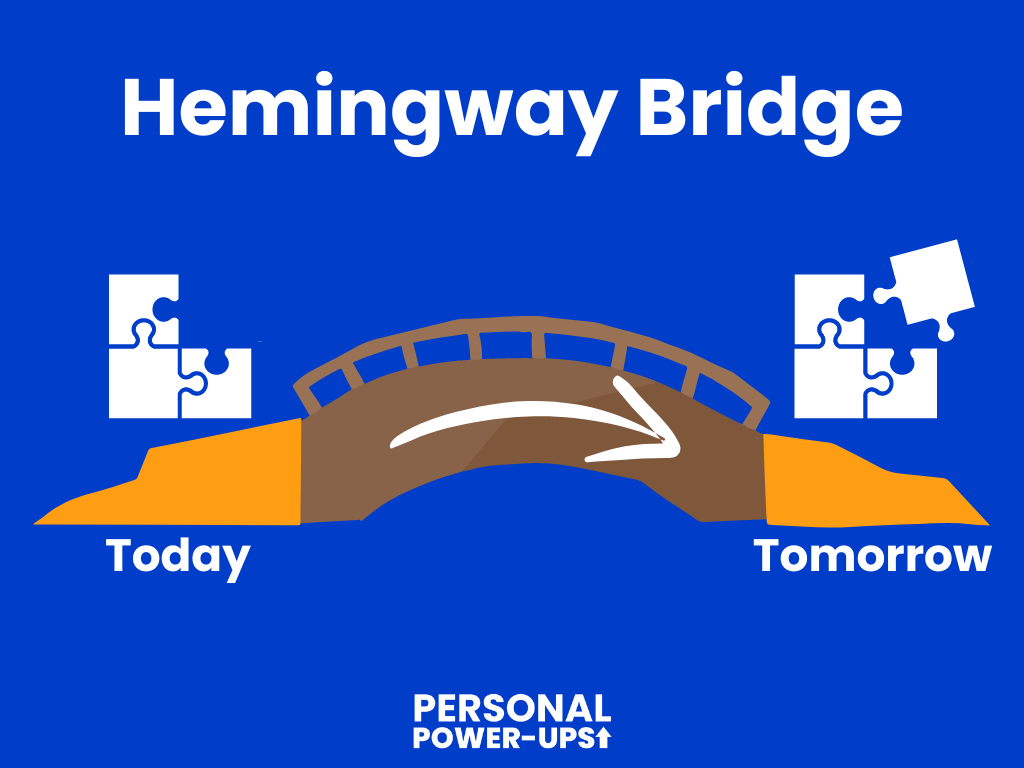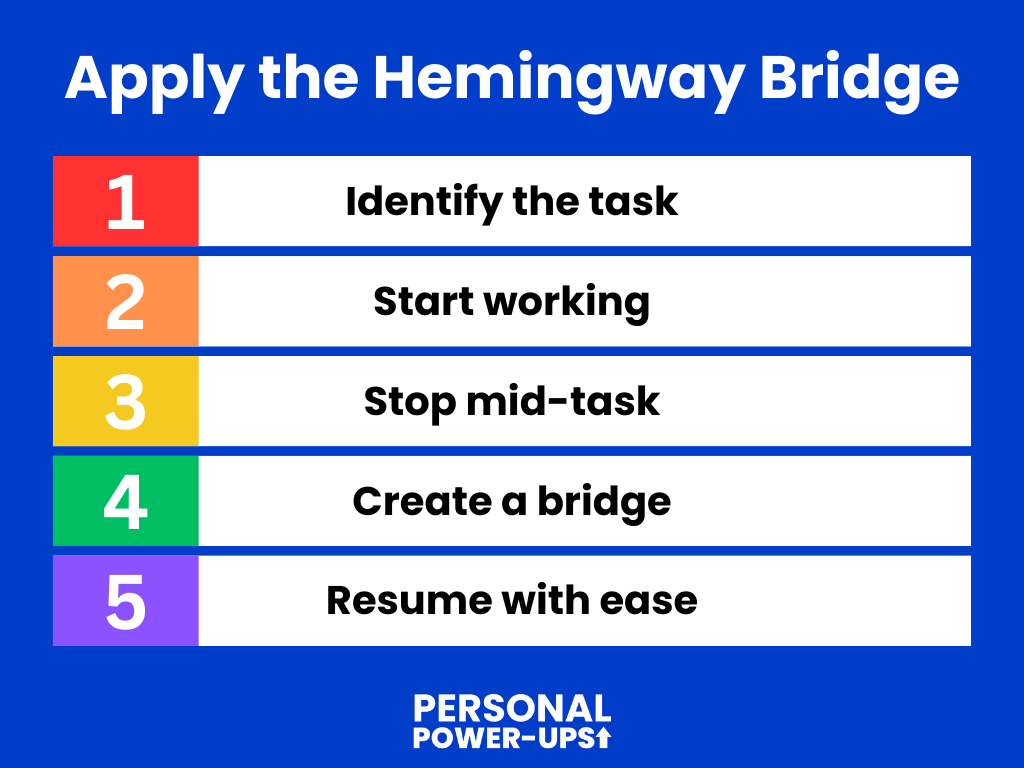Do you ever find yourself struggling to pick up where you left off? Starting your workday feels daunting, and the thought of diving back into a project seems overwhelming. What if I told you there’s a simple, effective method to increase your productivity and keep your momentum going strong? Enter the Hemingway Bridge Method.
Named after the legendary author Ernest Hemingway, this technique can transform how you work and build habits. It’s all about creating a smooth transition between your work sessions, making it easier to jump back in and continue your progress.
Table of Contents
What is the Hemingway Bridge Method?
The Hemingway Bridge Method involves stopping your work at a strategic point where you know exactly what comes next. Instead of working until you’re exhausted or completely finishing a section, you stop mid-task or mid-sentence. This creates a “bridge” to your next work session, making it much easier to resume work with clarity and motivation.
Hemingway himself often employed this technique in his writing. He would stop writing when he knew what would happen next, ensuring he could pick up his story seamlessly the next day. This method keeps your mind engaged and reduces the mental resistance associated with restarting a task.

The Science Behind the Hemingway Bridge
The Hemingway Bridge Method leverages two powerful psychological principles: the Zeigarnik Effect and the concept of micro-goals.
1. The Zeigarnik Effect: This phenomenon suggests that people remember unfinished tasks better than completed ones. By leaving a task unfinished, your brain remains engaged with it, making it easier to resume and complete it later.
2. Micro-Goals: Breaking tasks into smaller, manageable chunks makes them less daunting. Achieving these micro-goals provides a sense of accomplishment, motivating you to continue working.
Applying Hemingway’s Bridge
To incorporate this method into your routine, follow these steps:
1. Identify the Task: Choose the task you want to work on. Whether it’s writing a report, developing a presentation, or planning a project, clarity is key.
Example: If you’re writing a blog post, outline your main points and gather your research materials.
2. Start Working: Begin working on your task with focus and determination. Aim to make substantial progress, but remember you won’t complete it in one sitting. If you find it hard to start, be sure to apply the 5-minute rule.
Example: Write the introduction and the first main point of your blog post. Dive deep into your research and flesh out your ideas.
3. Stop Mid-Task: When you reach a natural stopping point, resist the urge to finish. Instead, leave off at a place where you know exactly what comes next.
Example: Stop writing in the middle of a paragraph or sentence. Jot down a quick note about what you plan to write next.
4. Create a Bridge: Make a note or a simple outline of the next steps. This bridge will guide you when you resume work, ensuring you can quickly get back into the flow.
Example: Note: “Discuss the benefits of the Hemingway Bridge Method and provide concrete examples.”
5. Resume with Ease: When you return to your task, review your notes and pick up where you left off. You’ll find it easier to dive back in and maintain momentum.
Example: Open your document, read the last few sentences, and continue writing from your note: “Discuss the benefits…”

Benefits of the Hemingway Bridge Method
1. Reduces Procrastination: Procrastination often stems from not knowing where to start. By using the Hemingway Bridge Method, you eliminate this uncertainty. You start each session knowing exactly what to do. This reduces the temptation to put off your work.
Example: Instead of staring at a blank screen, you’ll have a clear starting point, making it less likely you’ll procrastinate.
2. Enhances Focus: The method keeps your mind engaged with the task, even when you’re not actively working on it. This sustained focus improves the quality of your work.
Example: While taking a break or working on other tasks, your subconscious continues to process ideas for your blog post.
3. Maintains Momentum: Stopping in the middle keeps your momentum going. Your brain continues to process ideas even when you’re not actively working. This means you can pick up where you left off more easily.
Example: Picking up from a partially completed paragraph helps you stay in the flow, making it easier to complete your blog post.
4. Boosts Creativity: When you stop at a high point, you leave your brain in a state of active thinking. This keeps your creative juices flowing. The next time you sit down to work, you’re already in a creative mindset.
Example: As you mull over your blog post during breaks, you might come up with innovative angles or insights to include.
5. Reduces Mental Fatigue: Breaking tasks into smaller chunks prevents burnout. You’ll feel less overwhelmed and more energized to tackle your work.
Example: Instead of exhausting yourself by writing the entire blog post in one sitting, you’ll work in manageable, productive bursts.
Real-Life Applications of the Hemingway Bridge
Let’s look at how different professionals can apply this method to boost their productivity.
Writers
Writers can benefit immensely from the Hemingway Bridge. When working on a novel, stop mid-chapter or mid-scene. This creates a natural bridge to continue the narrative.
Example: If you’re writing a novel, stop just as your protagonist is about to make a crucial decision. Leave a note: “Continue with the protagonist’s internal struggle.”
Programmers
For programmers, stopping mid-function or after setting up a complex algorithm can help maintain flow and reduce the cognitive load of restarting.
Example: If you’re developing a new feature, pause after writing the pseudocode for the next section. Note: “Implement the data validation logic next.”
Designers
Designers can use the Hemingway Bridge by halting their work after creating a wireframe or initial sketch. This keeps the creative juices flowing.
Example: When designing a website, stop after drafting the homepage layout. Leave a note: “Continue with the ‘About Us’ page design.”
Project Managers
Project managers can use this method by ending their day after outlining the next steps for their team. This ensures a smooth handover and clear direction.
Example: Stop after listing the tasks for the upcoming sprint. Note: “Review the task list with the team first thing tomorrow.”




